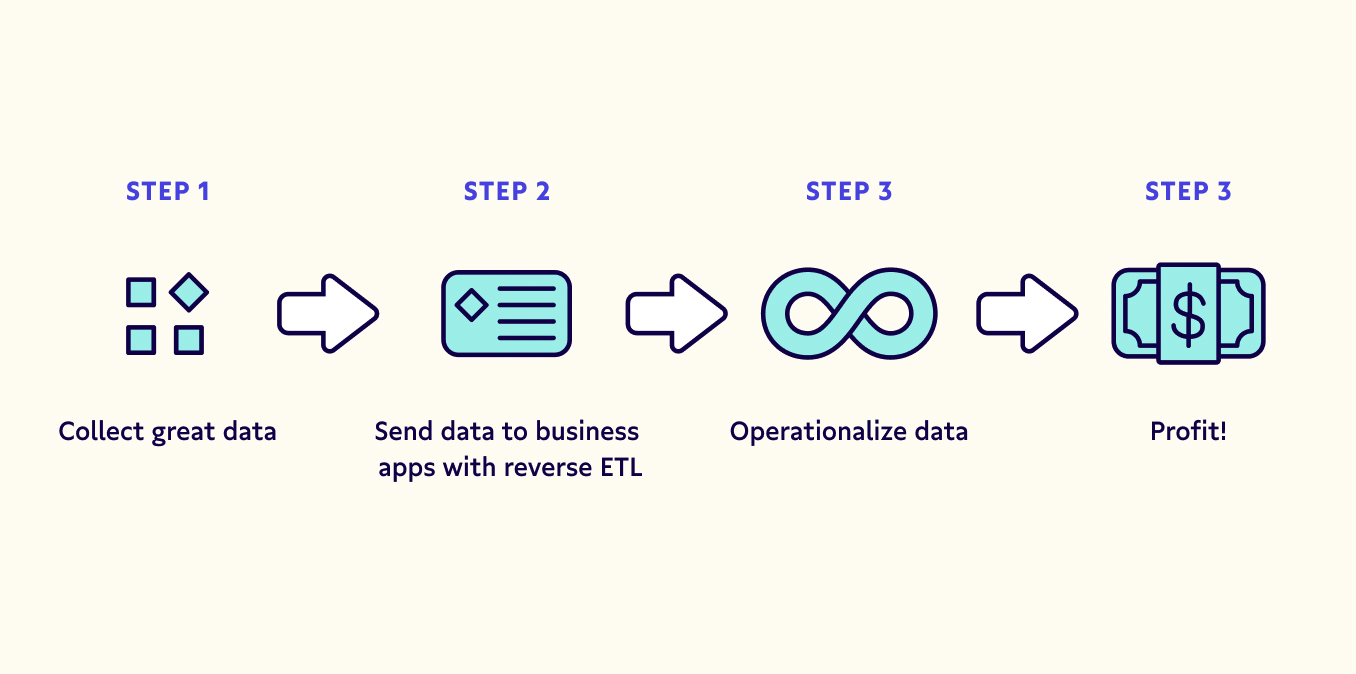
ETL, short for “extract, transform and load”, is the process of transferring data from an application to a data warehouse.
(For example, from a CRM like Salesforce into a data warehouse like Google BigQuery).
Table of Contents
Reverse ETL
Reverse ETL, as the name suggests, is the inverse of that process.
The reverse ETL process makes warehouse data actionable by feeding that data directly into third-party tools that an organization uses.
For example, someone using Salesforce can quickly have data about a group of customers sent into their Salesforce workflow.
Interest in reverse ETL tools has skyrocketed ever since the first batch of reverse ETL tools (like Census) were launched in the second half of 2021.
Why move data out of the warehouse?
The main reason to move data out of the warehouse and into an application is to make that data actionable.
A reverse ETL process can take data that might be difficult to query in a warehouse (like unstructured data) and make it available in an application where it can be easily manipulated.
This is especially important as more and more organizations adopt a “data-driven” approach to their business.
Being able to quickly get data into the hands of people who need it is critical for making decisions based on that data.
What are the benefits of reverse ETL?
There are many benefits of reverse ETL, but some of the most important ones are:
Quicker access to data
Moving data from a warehouse into an application means that people can access and use that data much more quickly.
Easier to use data
In many cases, it is much easier to use data in an application than it is in a warehouse.
This is because applications are designed to be user-friendly, while warehouses are designed for efficiency and scale.
Greater flexibility
Reverse ETL gives organizations the ability to move data into the tools they already use, rather than having to learn new tools or platforms.
What are the challenges of reverse ETL?
There are a few potential challenges with reverse ETL:
Data quality
Because reverse ETL moves data from a warehouse into an application, it is possible for bad data to make its way into the application.
This can cause problems down the line if that bad data is used to make decisions.
Understanding dependencies
Reverse ETL can be complex, and it is important to understand all of the dependencies involved in order to avoid potential problems.
Documentation
Reverse ETL processes can be difficult to document, which can make it hard for others to understand how they work.
Despite these challenges, reverse ETL is a powerful tool that can help organizations make their data more actionable and improve their decision-making process.
What are the use cases for Reverse ETL?
There are many possible use cases for reverse ETL, but some of the most common ones are:
Moving data from a data warehouse into a CRM
This can help sales teams have quick access to customer data.
Moving data from a data warehouse into an analytics platform
This can help organizations quickly analyze their data and make better decisions.
Moving data from a data warehouse into a marketing platform
This can help marketing teams segment their audiences and create more targeted campaigns.
Reverse ETL is a powerful tool that can help organizations make their data more actionable and improve their decision-making process.
Despite some potential challenges, reverse ETL is well worth considering for any organization that wants to make the most out of their data.
In terms of concrete fields, Reverse ETL can help with:
Operational analytics
Operational analytics can benefit from Reverse ETL in multiple ways.
First, data that is difficult to query in a warehouse (such as unstructured data) can be reverse ETL’ed into an application where it can be easily manipulated.
Second, reverse ETL can help keep data updated in near-real-time, which is critical for operational analytics.
Finally, reverse ETL can help organizations avoid the need to build and maintain their own data warehouses.
Compliance
Reverse ETL can also be used for compliance purposes.
For example, if an organization needs to keep track of customer interactions, reverse ETL can be used to send data from a CRM into a compliance platform.
This way, the organization can ensure that they are meeting all of its regulatory obligations.
Marketing
Additionally, reverse ETL can help marketing teams segment their audiences and create more targeted campaigns.
Data infrastructure
Reverse ETL is also becoming popular for moving data into cloud-based applications, like Salesforce, Box, and Workday.
This is because reverse ETL can quickly move data into these applications without the need for custom coding.
Reverse ETL tools are also becoming increasingly popular for moving data into Hadoop.
This is because reverse ETL can quickly and easily move large amounts of data into Hadoop, without the need for complex MapReduce jobs.
Data automation
Reverse ETL can also be used for data automation purposes.
For example, reverse ETL can be used to send data from a database into an application where it can be automatically processed.
This can help save time and money by eliminating the need for manual data entry.
How do I implement Reverse ETL?
If you’re interested in implementing reverse ETL, there are a few things you’ll need to do:
Choose the right tool
There are many reverse ETL tools on the market, so it’s important to choose one that will fit your needs.
Set up your data sources
You’ll need to configure your data sources so that they can be accessed by the reverse ETL tool.
Configure the reverse ETL process
This will involve setting up the connection between the data source and the destination, as well as choosing what data to move and how often to move it.
Test and monitor the process
Once the reverse ETL process is up and running, it’s important to monitor it closely to ensure
What’s next for Reverse ETL
Reverse ETL is part of the Operational Analytics trend.
Operational analytics is the process of using data analytics to improve efficiency and effectiveness.
The rise of new technologies (like reverse ETL) is why the operational analytics market is forecasted to grow by several multiples in size this decade.
The bottom line
Reverse ETL is a powerful way to make data more actionable and improve decision-making.
Reverse ETL is part of the operational analytics trend.
Operational analytics is the process of using data analytics to improve efficiency and effectiveness.
The rise of new technologies (like reverse ETL) is why the operational analytics market is forecasted to more than 3x by 2030.
Despite some potential challenges, reverse ETL is well worth considering for any organization that wants to make the most out of its data.
When it comes to operational analytics, reverse ETL is just scratching the surface of what’s possible.
The market for operational analytics is forecasted to grow significantly in the coming years, and new technologies (like reverse ETL) will play a big role in this growth.
So if you’re interested in staying ahead of the curve, reverse ETL is a technology you need to be aware of.


![Backwards 3: How to Type "Ɛ" [EASY]](https://softwareblade.com/wp-content/uploads/2022/02/Screen-Shot-2022-02-19-at-9.03.25-PM-150x150.png)